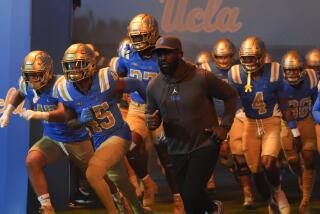In Order to Win, All UCLA Does Is Translate Homer
- Share via
Whenever the name Homer Smith comes up in football circles, you get the feeling right away we’re talking about some mad swami of the game here.
The word genius is loudly flapped about. You get a picture of a guy who lives in his own ivory tower and spends his time talking in X’s and O’s and drawing these incredibly complex and unstoppable formations that are years ahead of their time.
Rival coaches talk of him in whispers and study his formations on film the way art critics might study a Rembrandt.
You figure when he goes to a restaurant, five guys will be bidding for the tablecloth on the chance he has scribbled some dream play on there for the Rose Bowl.
Einstein might have inspired this kind of awe in mathematics, but in football the only comparable recent reputation to match Homer’s is Clark Shaughnessy’s.
Shaughnessy, you will remember, is the guy who reincarnated the T-formation in football for the Chicago Bears, who beat the Redskins with it, 73-0. At Stanford University, he took a team that was 1-7-1 and went 10-0 and won the Rose Bowl and the national championship and revolutionized the science of the football attack forever.
Like Shaughnessy, Smith is devoted to attack football, and like Shaughnessy, he seems to function best as a staff strategist, freed from the distractions of the head coaching job, although both he and Shaughnessy had success as head coaches.
What both have or had in common was the ability to look out at a football formation and see things other men couldn’t. Weaknesses that weren’t apparent to other coaches were like blinking lights to them.
This Homer’s career has been an odyssey, too. Football coaches, as a rule, come from the great football factories. Homer Smith went to Princeton.
When they leave coaching, it’s to go into television or auto sales. Homer Smith went into divinity school. At Harvard. Most football coaches get their degrees in PE. Homer Smith got an MBA in business. At Stanford.
Career coaches gravitate toward jobs in the Big Ten, or at Arizona or at Florida State. Homer Smith went to Army. Also, Davidson and the University of the Pacific.
If Homer Smith would seem overqualified to be mere offensive coordinator for UCLA’s football team, he doesn’t think so. “It’s the dessert of my coaching career,” he said.
He thought he was through with football and coaching when the call came from UCLA Coach Terry Donahue. Smith was at Harvard divinity at the time, canvassing various research foundations with a view toward studying the roots of religiosity as a cause of wars and methods to eliminate them.
“I had no notions of becoming another Billy Graham, but I still would like one day to put my studies there to use,” he said.
Smith had coached with Donahue on the staff at UCLA earlier, when the school used the wishbone-T, a doltish form of attack ill-suited to Smith’s philosophy.
At UCLA, what some know as “Air Donahue” is just another translation from Homer. It’s a unique system in which sometimes nondescript quarterbacks miraculously turn into combinations of Slingin’ Sammys and Broadway Joes, where walk-on receivers get more open than a Marseilles waterfront.
Tom Ramsey is suddenly a better quarterback than John Elway, and Rick Neuheisel passes Illinois right out of the Rose Bowl.
In the last four years, UCLA has completed 785 of 1,278 passes for 10,286 yards and 62 touchdowns.
For the Reverend Mr. Smith, it’s nothing new for the celestial game to succeed. Wherever he went, whether he was the head coach at Davidson or West Point, or an assistant at Stanford, UCLA or Air Force Academy, opposing secondaries knew the air game was going to be Homeric.
You might expect the office of this Einstein of the end zone to be a cluttered place with logarithms on blackboards or a cathode ray sputtering in the background or the swami himself turning out to be a wild-haired, four-eyed German-sounding crackpot--a great part for Sid Caesar.
But Homer Smith looks more like a vicar at tea. There’s no Roman collar, only a button-down, tieless shirt and a sweater with UCLA lettered in the corner. But the man who was a spinning fullback in college still manages to convey the impression that he might be measuring you to lay a block at any minute.
Football is a cerebral game, but Smith’s only concession to experimentation is a gridiron board with 22 pegs on it, round ones for the offense and pie-shaped ones in the cardinal colors of USC for the defense.
UCLA will play Iowa in the Rose Bowl on New Year’s Day, and Homer Smith is not worried, just interested.
“They are a very good football team with a very good coach,” he says of Iowa. “And when you give them that much time to prepare, you have to worry.”
Personally, if I were Iowa, I would worry more about what the good Dr. Smith does with his time. They’ll know what the castle felt like when Dr. Frankenstein disappeared into his laboratory with a bag full of bolts.
More to Read
Go beyond the scoreboard
Get the latest on L.A.'s teams in the daily Sports Report newsletter.
You may occasionally receive promotional content from the Los Angeles Times.










